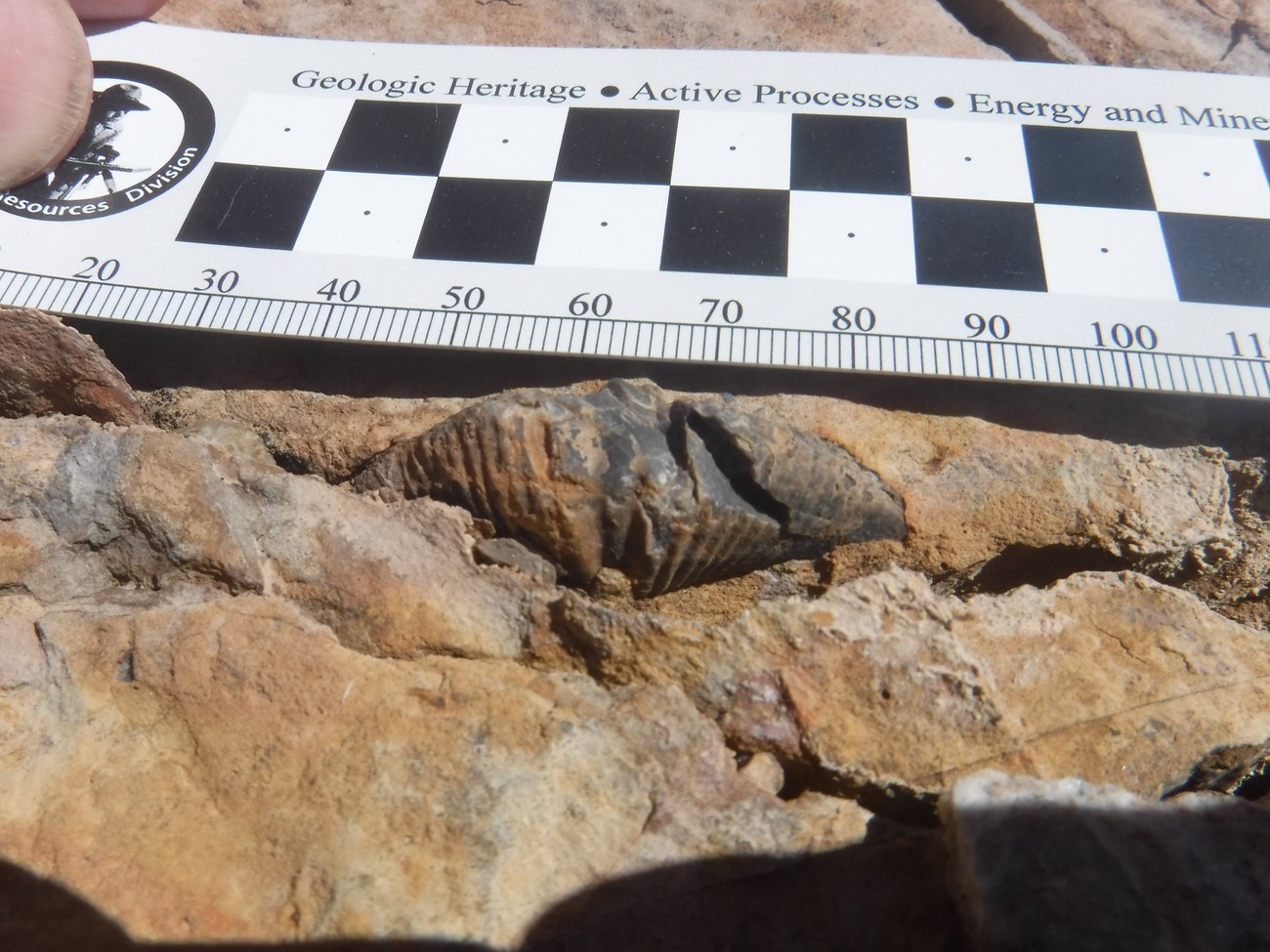Part of a series of articles titled Geologic Time Periods in the Paleozoic Era.
Article
Devonian Period—419.2 to 358.9 MYA

NPS image
Introduction
Before their Cambrian/Silurian naming controversy, Adam Sedgwick and Roderick Impey Murchison jointly named the Devonian System for the rocks of Devonshire in southern England, having done the actual work prior to their misunderstanding. Actually Devonshire is a poor type area because the rocks are intensely deformed and the base of the system is not exposed. Nevertheless, the rocks are fossiliferous, and their distinctive faunas—intermediate between those of the Silurian and the Carboniferous—led to their identification as the Devonian. Murchison and Sedgwick showed that fossils could be used to recognize the Devonian System in the Rhineland in Germany, where this age of rocks is much better exposed and much more fossiliferous (Eicher 1976).
Significant Devonian events
Along with the Silurian, the Devonian Period is called the “Age of Fishes.” However, plant, invertebrate, and other vertebrate lifeforms also experienced major changes in the Devonian. For instance, land plants began to show great diversification. Additionally, the first forests appeared, and the first seeds and soils developed, allowing plants to reproduce on dry land. The oldest fossils of insects and spiders date to this time. Early tetrapods, ancestors of land-dwelling vertebrates, first appeared during the Devonian. The Devonian ended with a mass extinction.
Learn more about events in the Devonian
At the beginning of the Devonian, terrestrial plants were generally small (an inch or so tall) and did not have roots, seeds, leaves, or woody tissue. Plant height was restricted because the organisms did not have tissues capable of dealing with the stresses associated with extensive vertical growth. The development of roots, seeds, leaves, and woody tissues provided the means for species diversification, growth into large trees, and finally the development of the first forests.
Roots improved water and nutrient absorption and the ability of plants to “anchor” into soil, which also appeared during the Devonian. Soil as we know it, with a high content of organic matter from decaying vegetation (and other organisms), developed as plants colonized the continents. Seeds allowed dissemination over longer distances and protected reproductive tissue during dry periods. Leaves provided more photosynthetic surface area for more efficient food production. Finally, the development of woody tissues (and efficient vascular systems) provided a mechanism to allow significant vertical growth.
The earliest insects were wingless. The habits and habitats of insects were widely diversified even in the Paleozoic, and their evolution must have been closely intertwined with the development of terrestrial plants and animals (Macdougall 1996). Today the insects are the most numerous terrestrial animals on Earth, both in terms of number of species and individuals.
Visit—Devonian Parks
Every park contains some slice of geologic time. Below, we highlight selected parks associated with the Devonian Period. This is not to say that a particular park has only rocks from the specified period. Rather, rocks in selected parks exemplify a certain event or preserve fossils or rocks from a certain geologic age.
-
Chesapeake and Ohio Canal National Historical Park (CHOH), West Virginia, Washington D.C., and Maryland—[CHOH Geodiversity Atlas] [CHOC Park Home] [CHOH npshistory.com]
-
Chickasaw National Recreation Area (CHIC), Oklahoma—[CHIC Geodiversity Atlas] [CHIC Park Home] [CHIC npshistory.com]
-
Cuyahoga Valley National Park (CUVA), Ohio—[CUVA Geodiversity Atlas] [CUVA Park Home] [CUVA npshistory.com]
-
Death Valley National Park (DEVA), California and Nevada—[DEVA Geodiversity Atlas] [DEVA Park Home] [DEVA npshistory.com]
-
Delaware Water Gap National Recreation Area (DEWA), New Jersey, and Pennsylvania—[DEWA Geodiversity Atlas] [DEWA Park Home] [DEWA npshistory.com]
-
Denali National Park (DENA), Alaska—[DENA Geodiversity Atlas] [DENA Park Home] [DENA npshistory.com]
-
Gates of the Arctic National Park and Preserve (GAAR), Alaska—[GAAR Geodiversity Atlas] [GAAR Park Home] [GAAR npshistory.com]
-
Glacier Bay National Park (GLBA), Alaska—[GLBA Geodiversity Atlas] [GLBA Park Home] [GLBA npshistory.com]
-
Noatak National Preserve (NOAT), Alaska—[NOAT Geodiversity Atlas] [NOAT Park Home] [NOAT npshistory.com]
-
Upper Delaware Scenic & Recreational River (UPDE), New York and Pennsylvania—[UPDE Geodiversity Atlas] [UPDE Park Home] [UPDE npshistory.com]
-
Whiskeytown-Trinity-Shasta National Recreation Area (WHIS), California—[WHIS Geodiversity Atlas] [WHIS Park Home] [WHIS npshistory.com]
-
Yukon-Charley Rivers National Park (YUCH), Alaska—[YUCH Geodiversity Atlas] [YUCH Park Home] [YUCH npshistory.com]
More about the Paleozoic
►
Tags
- chesapeake & ohio canal national historical park
- chickasaw national recreation area
- cuyahoga valley national park
- death valley national park
- delaware water gap national recreation area
- denali national park & preserve
- gates of the arctic national park & preserve
- glacier bay national park & preserve
- noatak national preserve
- upper delaware scenic & recreational river
- whiskeytown national recreation area
- yukon - charley rivers national preserve
- fossils
- paleontology
- geology
- geologic time
Last updated: April 28, 2023

